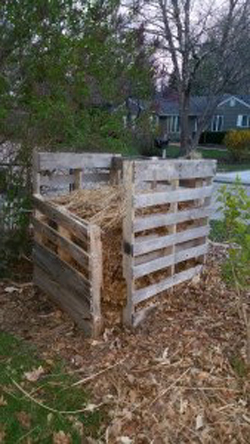I promised to write about how different methods of winter composting worked out. I used three outdoor methods, knowing that the composting process (i.e., rot) slows way down in the winter. I used a pallet bin, a compost tumbler, and I sheet-mulched a large area of lawn for a new pollinator garden.
|
LIVEGREEN |
by Anne Rivas |
It was my fault that the tumbler didn’t work. I had a good mix of green and brown materials, but not enough moisture or microbes. I should have added some dirt for the microbes necessary to the rotting process, and some of the commercial “starter” that came with the bin.
The advantages of using a tumbler are that you just turn the drum to mix and aerate the compost, and you don’t have the possibility of critters coming to live in it. The disadvantage is that you are re-creating a natural process in a closed environment and if you leave something out the process doesn’t work.
 |
Pallet bin |
The most successful method was the sheet mulch. The main problem with the sheet mulch is that I buried four sprinkler heads underneath it. The night before the irrigation company came to service the system, I spent a couple of hours digging down to locate the sprinkler heads. I found lots of exciting bugs, worms, and good, rich dirt, but no hardware. The sprinkler company found and marked the buried sprinklers for me.
To sum up, the tumbler is the least amount of work, but you have to keep tabs on the process. If you leave something out it doesn’t work. The pallet bin is more forgiving. It supplies dirt, microbes, and bugs, but it is more work to turn. Sheet mulch is great, but you need an area of lawn to sacrifice. Covering it with a few inches of bark mulch to keep the leaves in place through the winter would have been a good idea. And remember to mark the positions of sprinklers before covering them up!

